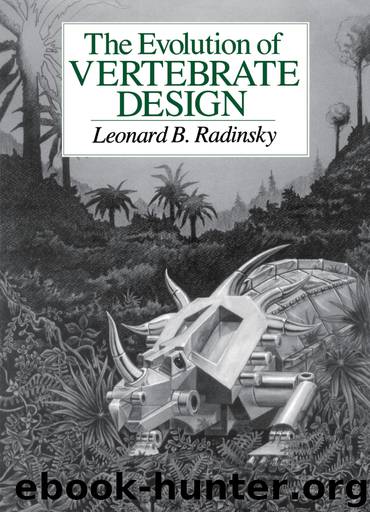The Evolution of Vertebrate Design by Leonard B. Radinsky

Author:Leonard B. Radinsky [Radinsky, Leonard B.]
Language: eng
Format: epub
Publisher: The University of Chicago Press
Published: 1987-11-27T16:00:00+00:00
Fig. 10.1 Phylogeny of living and extinct amphibians.
The relatively ponderous skeleton and short limbs (fig. 10.2) suggest that the majority of the labyrinthodonts were slow, clumsy walkers on land, and they probably were truly amphibious and spent much of their time lying about in shallow water, like modern crocodiles. The long jaws and sharp conical teeth indicate that they were predators, and the large palate teeth suggest that they fed on relatively large prey—probably fishes and possibly on each other. Some of the smallest labyrinthodonts were relatively lightly built, proportioned like modern lizards, and, like lizards, they probably fed mainly on terrestrial invertebrates (insects and the like). During the first 100 million years of their history, some lines of labyrinthodonts became better adapted for land life. They developed stronger limbs and vertebral columns and probably were completely terrestrial predators. Only one group (the diadectids) appears to have become herbivorous. We make this inference from their large bodies (up to 10 feet in length), their very small heads, and small, blunt, transversely widened teeth. Flattened teeth are characteristic of living herbivores from elephants to fish. The shape functions to increase the surface area available for grinding down tough plant material. The length of the jaws is highly correlated with the length of the head. As we learned in chapter 8, the length of the jaw is the out-lever in the system producing out-force at the tooth row. Shortening the out-lever is one biomechanical way to increase the out-force. Large forces are needed to break down tough plant material. It is surprising that only one group of amphibians became herbivorous, since there was an abundance of vegetation on land.
Download
This site does not store any files on its server. We only index and link to content provided by other sites. Please contact the content providers to delete copyright contents if any and email us, we'll remove relevant links or contents immediately.
Sapiens: A Brief History of Humankind by Yuval Noah Harari(14321)
The Tidewater Tales by John Barth(12626)
Mastermind: How to Think Like Sherlock Holmes by Maria Konnikova(7279)
Do No Harm Stories of Life, Death and Brain Surgery by Henry Marsh(6905)
The Thirst by Nesbo Jo(6881)
Why We Sleep: Unlocking the Power of Sleep and Dreams by Matthew Walker(6657)
Life 3.0: Being Human in the Age of Artificial Intelligence by Tegmark Max(5516)
Sapiens by Yuval Noah Harari(5324)
The Longevity Diet by Valter Longo(5042)
The Body: A Guide for Occupants by Bill Bryson(5030)
The Rules Do Not Apply by Ariel Levy(4910)
The Immortal Life of Henrietta Lacks by Rebecca Skloot(4550)
Animal Frequency by Melissa Alvarez(4428)
Why We Sleep by Matthew Walker(4394)
The Hacking of the American Mind by Robert H. Lustig(4339)
Yoga Anatomy by Kaminoff Leslie(4333)
All Creatures Great and Small by James Herriot(4271)
Double Down (Diary of a Wimpy Kid Book 11) by Jeff Kinney(4242)
Embedded Programming with Modern C++ Cookbook by Igor Viarheichyk(4141)
